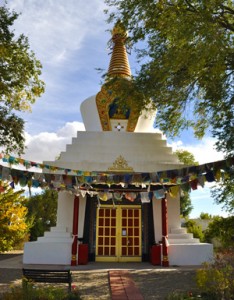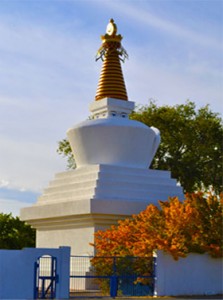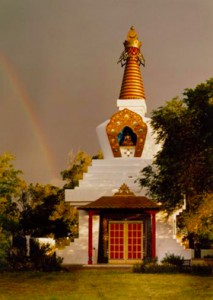 The Stupa is a symbol of Dharmakaya, the universal principle of all consciousness, and has the mystical power of liberation through seeing. When one sees the stupa, a deep imprint in the viewer’s mind arouses Bodhicitta and this ripens to full enlightenment. This applies even to insects. Rainbow-like visions of the stupa appeared to those who witnessed the major events of the Buddha’s life. His enlightened actions so utterly purified the ignorant fixations of the moment that the Dharmakaya manifested as pure form in the sky. Later, replicas of these visions were built and venerated, becoming the earliest Buddhist shrine objects. They proliferated in many cultures in various adapted styles and often enshrined the relics of great saints, thus focusing people’s devotion. In the Tibetan tradition, the stupa illuminates the entire path of inner, outer and secret levels. It is a fearless proclamation of truth.
The Stupa is a symbol of Dharmakaya, the universal principle of all consciousness, and has the mystical power of liberation through seeing. When one sees the stupa, a deep imprint in the viewer’s mind arouses Bodhicitta and this ripens to full enlightenment. This applies even to insects. Rainbow-like visions of the stupa appeared to those who witnessed the major events of the Buddha’s life. His enlightened actions so utterly purified the ignorant fixations of the moment that the Dharmakaya manifested as pure form in the sky. Later, replicas of these visions were built and venerated, becoming the earliest Buddhist shrine objects. They proliferated in many cultures in various adapted styles and often enshrined the relics of great saints, thus focusing people’s devotion. In the Tibetan tradition, the stupa illuminates the entire path of inner, outer and secret levels. It is a fearless proclamation of truth.
 The Bodhi Stupa contains the auspicious vases of Ksitigarba, Jambala, the mandalas of the Stainless Light and Stainless Ushnika, the specially prepared tsatsa, the life force post, the relics, and especially the great Dharanis, combined with the unfathomable samadhi power of the actual consecration and the continuous, great-minded devotion of the students who built the stupa, making a powerful blessing in the world. The stupa is a center of tremendous Buddha activity, drawing the Buddhas to earth, speeding the rebirth of lamas, promoting longevity, creating harmony in the Sangha, manifesting wealth, turning back invading armies, pacifying pestilence and disease, and actualizing enlightenment. With the building of this Stupa, the world is offered a powerful blessing for Peace and Happiness. Individuals may find calm and inspiration by meditation in and around the stupa. If they take up the Noble Path to realization, they will find great fulfillment.
The Bodhi Stupa contains the auspicious vases of Ksitigarba, Jambala, the mandalas of the Stainless Light and Stainless Ushnika, the specially prepared tsatsa, the life force post, the relics, and especially the great Dharanis, combined with the unfathomable samadhi power of the actual consecration and the continuous, great-minded devotion of the students who built the stupa, making a powerful blessing in the world. The stupa is a center of tremendous Buddha activity, drawing the Buddhas to earth, speeding the rebirth of lamas, promoting longevity, creating harmony in the Sangha, manifesting wealth, turning back invading armies, pacifying pestilence and disease, and actualizing enlightenment. With the building of this Stupa, the world is offered a powerful blessing for Peace and Happiness. Individuals may find calm and inspiration by meditation in and around the stupa. If they take up the Noble Path to realization, they will find great fulfillment.
 Upon entering the Bodhi stupa, one’s attention is first drawn to the wall in front (South wall) where sits the his
Upon entering the Bodhi stupa, one’s attention is first drawn to the wall in front (South wall) where sits the his
toric Buddha Shakyamuni who first turned the wheel of Dharma in 500 BC. The very heart of the Buddhist teachings is the viewpoint that all sentient beings have Buddha nature incidentally obscured by ignorant fixation on ego. This Buddha nature in its primordial form is represented by the small figure of Samantabhadra and Samantabhadri at the top. The Buddha nature naturally manifests as the five wisdoms that are represented by the five Buddha families.
 Starting from the right on the Southern wall is Akshobya of the Vajra family who represents the mirror-like wisdom; Amitabha of the Lotus family represents the wisdom of discriminating awareness; Vairochana of the Buddha family represents the Dharmadhatu wisdom; Amoghasiddhi of the Karma family represents the all-encompassing wisdom; and Ratnasambhava of the Ratna family represents the wisdom of equanimity. These five Buddhas manifest in the deluded states of sentient beings as the five skandhas and five kleshas. When these five skandhas and kleshas are seen exactly as they are, the mandala of the five Dhyani Buddhas is seen as being the true nature of mind. This is basically the aim of Buddhism.
Starting from the right on the Southern wall is Akshobya of the Vajra family who represents the mirror-like wisdom; Amitabha of the Lotus family represents the wisdom of discriminating awareness; Vairochana of the Buddha family represents the Dharmadhatu wisdom; Amoghasiddhi of the Karma family represents the all-encompassing wisdom; and Ratnasambhava of the Ratna family represents the wisdom of equanimity. These five Buddhas manifest in the deluded states of sentient beings as the five skandhas and five kleshas. When these five skandhas and kleshas are seen exactly as they are, the mandala of the five Dhyani Buddhas is seen as being the true nature of mind. This is basically the aim of Buddhism.
These teachings of the Buddha descended through various lineages that are represented on the walls of the stupa. On the East wall (to the left) is the lineage of the Shangpa Kagyu whose present lineage holder is H.E. V.V. Kyabje Kalu Rinpoche who follows Kalu Rinpoche, the founder of the Center. Also on the East wall is the representation of the lineage of Padmasambhava (Guru Rinpoche) who brought Buddhism to Tibet, and Shijay lineage of Machig Labdron who introduced the Chöd practice that cuts through neuroses. On the West wall (to the right) is depicted the Karma Kagyu lineage which was brought to Tibet by Marpa the translator. Marpa studied in India under the great Siddha Naropa, whose teacher was Tilopa, and whose present lineage holder is the Karmapa.
